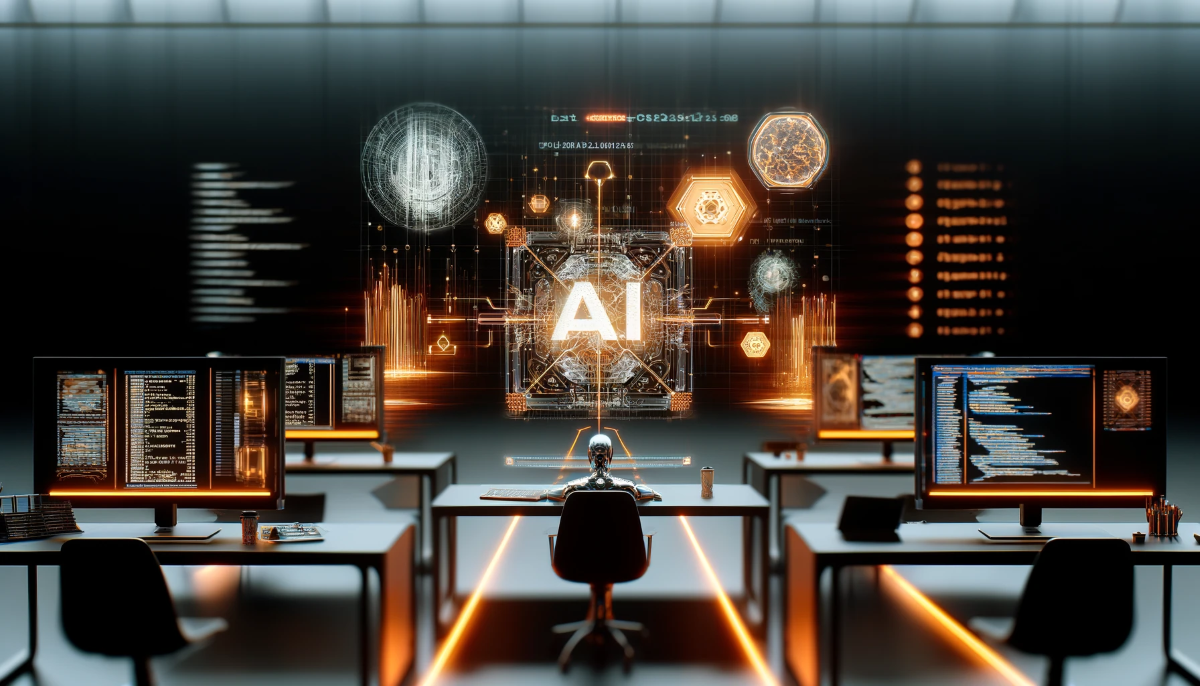4-minute read
Quick summary: We explore how generative AI is revolutionizing software development, how to navigate the challenges inherent in the approval process, and how to ensure smooth, timely adoption.
In the rapidly evolving world of technology product development, the push for efficiency and innovation is relentless. As businesses navigate the competitive landscape, effective adoption of cutting-edge tools to streamline coding and development processes is becoming critical. Enter generative AI (Gen AI), a revolutionary force reshaping how software is conceived, developed, and brought to market. Advanced tools like ChatGPT, Code Whisperer, and GitHub Copilot not only promise to enhance developer productivity, but also signal a significant shift in the paradigms of coding and product development.
Offering unprecedented speed and efficiency when used appropriately, Gen AI tools are designed to assist developers by suggesting code snippets, completing coding tasks, and even automating some aspects of the coding process. These capabilities not only accelerate development project timelines, but also dramatically shorten the time-to-market for new software products.
How Gen AI is reshaping the developer experience
As a famous anecdote goes, Albert Einstein was once asked by one of his students for his phone number … upon which the scientist promptly grabbed a directory and looked it up.
“You don’t remember your own phone number?” asked the startled student.
“No,” Einstein replied. “Why should I memorize something I can get so easily from a book?”
For today’s developers, Gen AI coding tools are the equivalent of Einstein’s phone directory: easily accessible sources of simple solutions that can free up brain space for addressing more challenging issues.
Here are just a few ways Gen AI is changing the developer experience for the better … along with some cautionary notes about proper usage of these powerful platforms.
Boost efficiency and job satisfaction
Generative AI tools like ChatGPT, Code Whisperer, and GitHub Copilot are particularly effective in automating mundane tasks such as generating boilerplate code, writing unit tests, and setting up authentication processes. This automation frees up valuable time for developers, allowing them to focus on solving higher-level problems and developing innovative solutions. The result is not just an increase in productivity, but also an enhancement in job satisfaction, as developers can engage more deeply with the creative aspects of their work.
Accelerate learning and adaptation
Technology evolves at a breakneck pace, and staying updated with the latest frameworks and languages is a constant challenge. Generative AI can serve as an on-demand sherpa, offering immediate solutions and insights that would normally require extensive research. This capability is invaluable for quickly learning new technologies or finding efficient ways to implement complex functionalities. Moreover, it supports developers in debugging and optimizing code, leading to improved overall code quality and performance.
Caveat emptor
Successful utilization of generative AI in software development hinges on the developer’s ability to apply expert judgment. While these tools can suggest solutions and generate code, they cannot fully comprehend the intricacies of specific project requirements or the nuances of design decisions. It’s crucial for developers to critically evaluate generative AI outputs, integrating suggestions with their deep understanding of the project’s goals and technical standards. This blend of AI-generated insights and human expertise paves the way for more efficient, innovative, and successful development projects.
For today’s developers, Gen AI coding tools are the equivalent of Einstein’s phone directory: easily accessible sources of simple solutions that can free up brain space for addressing more challenging issues.
Navigating the approval bottleneck
Securing the necessary approvals can present a significant challenge for companies eager to adopt generative AI and cloud technologies. The enthusiasm for these innovative tools often clashes with the realities of security, compliance, and governance requirements, creating a complex landscape for IT decision making. Ensuring these solutions meet stringent standards without stifling innovation requires a delicate balance.
Rapid deployment of Gen AI tools must be weighed against the need for thorough evaluation to mitigate risks and align with regulatory mandates. Understanding this balance is crucial for organizations to harness the benefits of Gen AI while maintaining robust security and compliance postures.
Ensuring smooth Gen AI adoption through governance
AI governance and compliance are vital elements in the adoption of generative AI tools for product development. By establishing clear standards and governance protocols, enterprises can more effectively navigate the complexities of the adoption process.
For IT decision-makers, streamlining this process involves a proactive approach that encompasses
- Engaging early with compliance teams to understand potential roadblocks
- Leveraging in-house compliance expertise to ensure Gen AI tools meet all regulatory and organizational standards from the outset
- Developing a clear communication strategy that outlines the benefits and safeguards of Gen AI tools to support timely approval and integration
By establishing clear standards and governance protocols, enterprises can more effectively navigate the complexities of the adoption process.
Best practices in accelerating Gen AI integration
To fast-track the integration of generative AI in product development, it’s crucial to adopt a strategic approach that starts with a solid foundation:
- Prioritize transparency and education across IT, security, compliance, and development teams to ensure alignment on the adoption of Gen AI technologies.
- Implement a phased rollout plan for Gen AI coding tools, starting with pilot projects to gauge effectiveness and address issues early on.
- Establish a framework for continuous monitoring and evaluation to ensure Gen AI tools can adapt to evolving business needs and maintain compliance.
This collaborative, measured approach accelerates the adoption process while also maximizing the potential of Gen AI technologies to streamline product development.
Embracing the future of product development with Gen AI
Generative AI is much more than just another technological advancement; it’s a catalyst for a paradigm shift in software development. By enabling faster coding, automating routine tasks, and facilitating rapid learning, Gen AI tools are poised to redefine how developers work, improve productivity, and bring products to market more swiftly. At the same time, harnessing these benefits requires navigating the complexities of IT governance and ensuring compliance while fostering a culture of continuous innovation. As we stand at the cusp of this revolution, the onus is on IT leaders to champion these tools responsibly, ensuring that as organizations race towards the future, they remain anchored in the principles of security, compliance, and ethical use of these intelligent technologies.

Breaking new ground in digital transformation
We create powerful custom tools, optimize packaged software, and provide trusted guidance to enable your teams and deliver business value that lasts.



